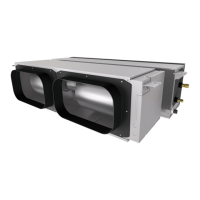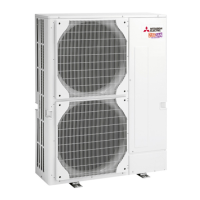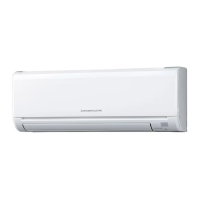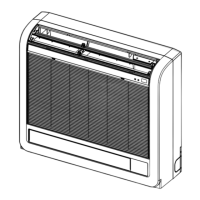8
6. Refrigerant piping work
Warning:
Be careful of ying are nut! (Internally pressurized)
Remove the are nut as follows:
1. Loosen the nut until you hear a hissing noise.
2. Do not remove the nut until the gas has been completely released (i.e.,
hissing noise stops).
3.
Check that the gas has been completely released, and then remove the nut.
Outdoor unit connection
Connect pipes to stop valve pipe joint of the outdoor unit in the same manner
applied for indoor unit.
• For tightening use a torque wrench or spanner, and use the same tightening
torque applied for indoor unit.
Refrigerant pipe insulation
• Afterconnectingrefrigerantpiping,insulate thejoints(aredjoints)withthermal
insulation tubing.
[Fig. 6-3-2]
Ⓒ
Ⓓ
Ⓕ
Ⓔ
Ⓙ
Ⓘ
Ⓛ
Ⓔ
Ⓕ
Ⓛ
Ⓞ
20
20
20
20
Ⓐ
Pipecover(small)(accessory)
Ⓑ
Caution:
Pulloutthethermalinsulationontherefrigerantpipingatthesite,inserttheare
nuttoaretheend,andreplacetheinsulationinitsoriginalposition.
Take care to ensure that condensation does not form on exposed copper piping.
Ⓒ
Liquid end of refrigerant piping
Ⓙ
Flare nut
Ⓓ
Gas end of refrigerant piping
Ⓚ
Return to original position
Ⓔ
Site refrigerant piping
Ⓛ
Ensure that there is no gap here
Ⓕ
Main body
Ⓜ
Plate on main body
Ⓖ
Pipecover(large)(accessory)
Ⓝ
Band(accessory)
Ⓗ
Thermalinsulation(eldsupply)
Ⓞ
Ensure that there is no gap here.
Place join upwards.
Ⓘ
Pull
1.
Remove and discard the rubber bung which is inserted in the end of the unit piping.
2. Flare the end of the site refrigerant piping.
3. Pull out the thermal insulation on the site refrigerant piping and replace the
insulation in its original position.
Cautions On Refrigerant Piping
Be sure to use non-oxidative brazing for brazing to ensure that no foreign
matter or moisture enter into the pipe.
Be sure to apply refrigerating machine oil over the flare connection
seating surface and tighten the connection using a double spanner.
Provide a metal brace to support the refrigerant pipe so that no load is
imparted to the indoor unit end pipe. This metal brace should be provided
50 cm away from the indoor unit’s are connection.
6.4. Purging procedures leak test
PURGING PROCEDURES
Connecttherefrigerantpipes(boththeliquidandgaspipes)betweentheindoor
and the outdoor units.
Remove the service port cap of the stop valve on the side of the outdoor unit gas pipe.
(The stop valve will not work in its initial state fresh out of the factory (totally closed
withcapon).)
Connect the gage manifold valve and the vacuum pump to the service port of the
stop valve on the gas pipe side of the outdoor unit.
Runthevacuumpump.(Vacuumizeformorethan15minutes.)
Check the vacuum with the gage manifold valve, then close the gage manifold valve,
and stop the vacuum pump.
Leave it as is for one or two minutes. Make sure the pointer of the gage manifold valve
remainsinthesameposition.Conrmthatthepressuregageshow-0.101MPa(-760
mmHg).
Pipe length :
7 m maximum
No gas charge is needed.
Pipe length exceeding 7 m
Charge the prescribed
amount of gas.
Remove the gage manifold valve quickly from the service port of the stop valve.
After refrigerant pipes are connected and evacuated, fully open all stop valves on
gas and liquid pipe sides.
Operating without fully opening lowers the performance and causes trouble.
Hexagonal wrench
*4 to 5 turns
Stop valve
(or the vacuum
pump with the
function to
prevent the back
ow)
Gauge manifold valve
(forR32/R410A)
Pressure gauge
(forR32/R410A)
Compound pressure
gauge(forR32/R410A)
-0.101MPa
(-760mmHg)
Handle
Low
Handle High
Window
Charge hose
(forR32/R410A)
Vacuum
pump
Adapter for
preventing
thebackow
Charge hose
(forR32/R410A)
Service port
Stop
valve
*Close
*Open
Stop valve
Tighten the cap to the service port to obtain the initial status.
Retighten the cap
Leak test
6.5. Drain piping work
[Fig. 6-5]
ⒶⒷ
Ⓕ
Ⓓ
Ⓗ Ⓘ
Ⓙ
Ⓔ
Ⓒ
Ⓖ
Ⓐ
Insulator
Ⓕ
35 mm
Ⓑ
Drain pipe R1
Ⓖ
Downward slope 20 mm/m or more
Ⓒ
Drain pan
Ⓗ
Drain trap
Ⓓ
70 mm
Ⓘ
The drain pipe should extend below this level.
Ⓔ
2
×
Ⓕ
70 mm
Ⓙ
Open drain

